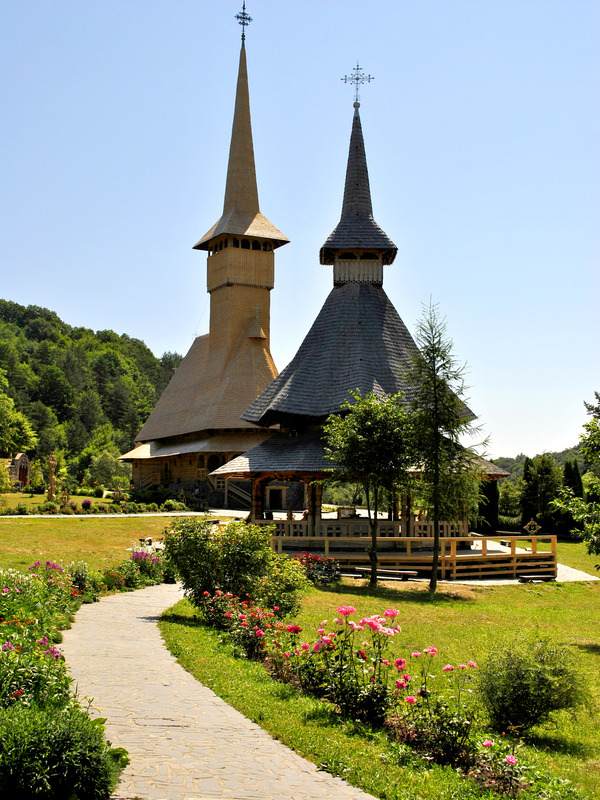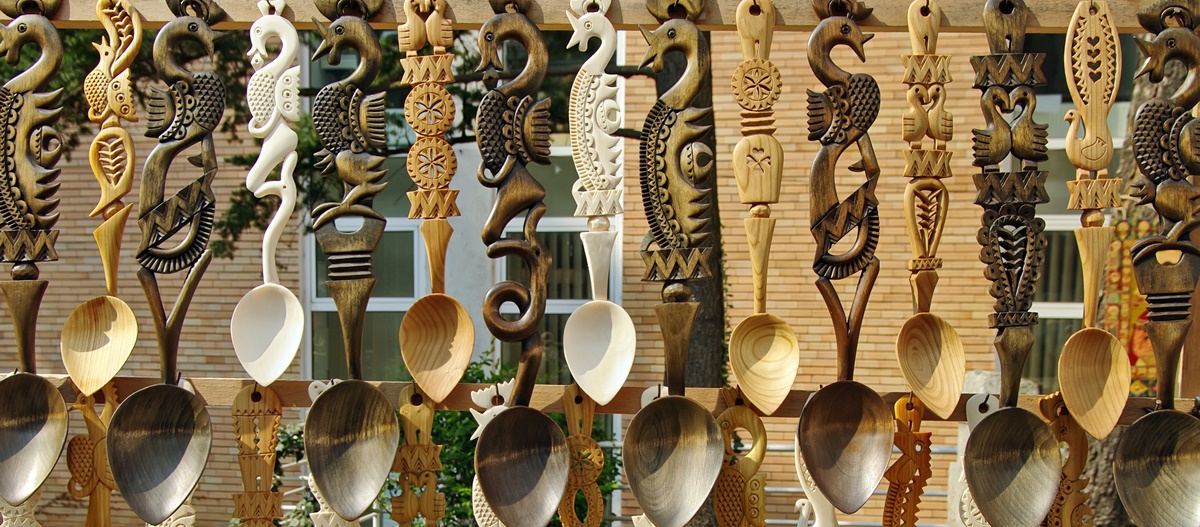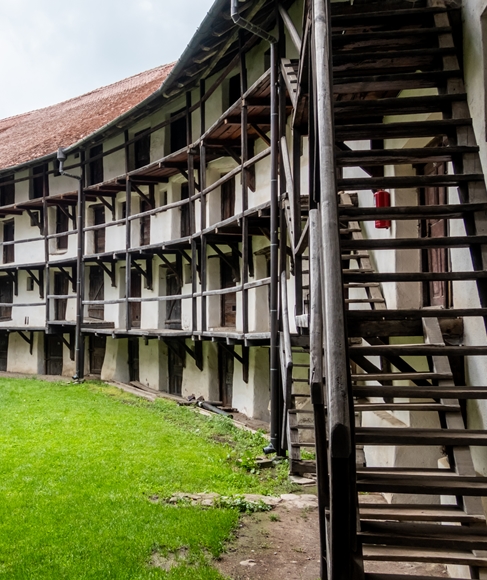Wood craft has been part of the Romanians’ life since ancient times. Once, every peasant possessed basic knowledge of wood crafting and the skills to use it in the household, the technique being raised to the level of art in many cases. Among the variety of the objects made of wood we mention those used in the kitchen (spoons, bowls, forks, holders), in agricultural work (hayforks, rakes, ox carts, wheels), also as furniture (wardrobes, beds, dowry chests), etc. Another category of the wood objects served as decorations with different traditional motifs, used for a specific purpose and bearing special symbolism – traveling in Romania one would see wood constructions decorated with motifs as: sun, flower of life, fir tree, animal heads (horse, wolf), soul bird, seed of life, or rope.
The wood used to craft objects and create furniture and construction pieces would vary from the flexible Hazelwood and dogwood – used for shepherd staff, to the light species as poplar or willow – for kitchen furniture, or the harder varieties as fir and oak, being used for construction structures.
This tour takes you through romanian villages (and village museums!) that will show you exactly the big role played by this craft.
Departures: all year
Duration: 9 days
PRIVATE TOUR: private tour

After your arrival, you will have a short tour downtown of the old district before accomodation for the night.

A first introduction to the rural features of Romania – visit in the morning to the Village Museum from Bucharest.
Then, short drive outside of the capital, to Comana village.
Visit at the Craftsmen village and Comana Monastery. At the Craftsmen Village a team of young enthusiasts have created a space where old and almost forgotten techniques of hand work are still practiced in a few workshops as woodwork, reed mace processing, pottery, weaving, traditional milling, blacksmith's workshop and natural processing of fruit, vegetables and medicinal plants. The wood work is visible just by observing the constructions from the village, the small houses-workshops meant for crafts. The wood workshop uses the locust tree wood as a main material (which is specific to Comana, by the way), trying to create a "curtain" of vertical elements, arranged according to rhythms differently adapted to the function of each space.
Comana Monastery – founded by Vlad the Impaler in the 15th century and then rebuilt in several stages it is considered by some historians as the burial place of him, hence the attractiveness of the place; the monastic settlement stands out through its size, a massive stronghold placed near the river.
Return to Bucharest at the hotel.

After breakfast, departure for Sibiu. After a long drive to Sibiu, visit to the Astra Museum, opened in 1963, spreading across 96ha in the beautiful outdoor scenery of Dimbrava Sibiului, a forest and lake complex. The museum gathers 4 sections including ethnology, folk traditions, and history of the Transylvanian region. It is considered the Europe’s largest open-air ethnographic museum, containing a large variety of households and other rural related buildings as, churches, mills, shrines, etc.
Accommodation in Sibiu, at 4* hotel, conveniently located near the old centre.

Short morning walking tour of the medieval Sibiu. With the traces of the first settling back to 1191 Sibiu represented the main administrative center of the German ethnic group of colonists (Saxons), which inhabited the Southern Transylvania starting to the 13th century. The Historic Centre and its Ensemble of Squares was added on the UNESCO Tentative list in 2004. Our sighs are enchanted by beautiful old architecture of the residential, ecclesiastic or military constructions from the Old Center.
Leaving for Biertan fortified church, another UNESCO ecclesiastic establishment worth a visit. Founded during the 15th – 16th centuries, the church features a Late Gothic predominant architectural style with Romanesque elements. Submitted to UNESCO as early as 1993, its importance resides mainly from the fact that it was the see of the Transylvanian Lutheran Church for roughly three centuries (1572 – 1867). The church was built in the middle of the village and dominates the landscape of the surrounding area. It has three fortification walls, linked by gate towers, eight towers and the church itself was equipped from the very beginning with solid defensive elements.
Afternoon in Sighisoara. Named also Schäßburg, the city along with other six Transylvanian Saxon fortified cities, gave the German name of Transylvania which is ‘Siebenbürgen’, hence the number of major medieval settlements built by the German settlers in the. The city is an outstanding testimony to the culture of the Transylvanian Saxons, which continue to exist due to its architectural and urban monuments. Still inhabited nowadays, the historic center of Sighisoara is the most representative mediaeval urban site of Transylvania, UNESCO listed in 1999 – it has preserved almost intact the city organization (street network, plot system) as well as the architectural worth of its constructions. In the Citadel Square we visit a particular shop placed in the basement of a traditional Saxon house, covering the work a few artists ranging from intricately carved wood spoons to peasant-style clay statues, painted-glass icons or Easter eggs. Short presentation of the workshop will be provided by request.
Accommodation in Sighisoara at 4* hotel.

Drive up to the northern Romania towards the most traditional region, when it comes about the wood work, Maramures, idyllic lowland surrounded by the Carpathians.
The history of Maramures region lives through the eyes of its wooden churches. Over the centuries, the foreign rulers of the region did not allow the locals to build long lasting stone churches, so, the carpenters living there erected exquisite wooden churches to find their way to God.
The first sight from Maramures is Desesti Church, UNESCO listed, as well. The church from Desesti was built in 1770 on the site of an older church. The construction has preserved its original form. The interior paintings done in 1780 are remarkably well-preserved, illustrating classical Biblical themes, but adding also some particular scenes. The shades of red are predominating, the chromatic pattern being underlined by the white Maramures towels that adorn the church furniture. One of the most beautiful scenes is the River of Fire, represented on the southern wall. Relics of the Celtic civilization (tombstone crosses) can be found in the churchyard cemetery.
Accommodation in Breb village for 2 nights, a marvelous example of the traditional Maramures, at 3* Guesthouse, dinner included (local food).

The region is predominantly rural, each village is in itself a living museum, populated with people whose life unfolds quite naturally among the "exhibits". Each settlement seems to be a "village museum", with unpaved lanes, guarded on either side by farmhouses and outbuildings made entirely of wood - genuine monuments of folk art and architecture.
Barsana village represents an excellent example in that sense, among the beautifully carved gates and houses made of wood, two religious settlements getting noticed – the 1720 UNESCO church and the stunning monastic complex built recently. Regarding the skilled wood artisans, we pay a visit to Teodor Barsan, porbably the most famous carpenter known in Maramures – his work, relying from the small crucifixes and spoons to the majestic shrines and gates is well-known in Romania and all over the world, as well. He represented Romania in countless international art exhibitions, UNESCO recognizing him as a Living Human Treasure, an honor bestowed on those individuals who embody the true spirit of a nation's traditions.

Drive back to Transylvania.
The Szekler land is placed at the east part of the region, the Carpathian foothills serving as natural barrier for the local population against many invasions during the Middle Age. The region is famous for the beautiful carved and painted wood gates, mentioned since the 17th century. The traditional gates have usually three supporting pillars, and two gates – the big one, for horse and cart, and the small gate, for pedestrians. The particular element that makes the difference with the gates from Maramures is done by the superior part - a transverse beam that has a pigeon loft or dovecot covered with a shingles roof on top of it. Decorations include geometrical, vegetative and zoomorphic motifs as spirals, rounds, flowers (lily, rose, and tulip), grape wine, palm leave, rooster or dove, while the colors used are red, white, green and blue.
One of the most representative series of gates from the Szekler land is housed by Mini Transilvania Park from Odorheiu Secuiesc which we will visit. Accommodation in the area at 3* rural Guesthouse.

The Saxon heritage relies mostly on developing a specific land-use system, settlement pattern and organization of the family farmstead that have been preserved since the late Middle Age. And particularly on the wood working, by creating the structure of barns, tools for agriculture, and beautiful colored furniture and decorative elements for the interior. The rural community retains a valuable architectural heritage that includes an impressive Lutheran fortified church, mainly built in Romanesque and Gothic style, and a predominantly traditional rural settlement consisting of colorful farmhouses of medieval foundation and Baroque appearance.
We arrive at Viscri. Viscri is best known for its highly fortified church, UNESCO listed, originally built around 1100 AD by the Szeklers - a must visit! The traditional crafts represent the result of the elaborate work of the villagers, an ethnic mix who joined together in this enterprise: the Blacksmith workshop is operated by a Roma villager, as well as horse-cart ridings in the village and its proximity, while the handmade felt shoes are made by new settlers that came in the village in the 90’s from Western Germany.
For accommodation - a traditional Viscri house.

Before crossing the mountains towards Bucharest we take a break at Prejmer, in order to visit the UNESCO 13th century early Gothic fortified church, probably the biggest of its kind from Europe. What makes the church unique is its layout – from the initial Greek cross shape to the Latin cross feature in the 16th century; then the massive circular fortification walls (12m tall and 4m thick), that could comprise the entire village in the 270 rooms organized inside, during the sieges.
Arriving at Bucharest by evening. End of tour.
PRIVATE TOUR by car/minivan
*ask for a quotation depending on the number of people travelling together
- Professional guide assistance, English speaking (or other languages upon request), during the whole trip;
- Transport by private modern AC car/mini-van (fuel and parking fees incl) during the whole trip;
- Airport pick-up, drop-off (upon request);
- 8 nights accommodation at 3* hotel/guesthouse with breakfast;
- Dinners on day 5,6, 8;
- Entrance fees to the touristic attractions;
- Photography fees;
- Meals other than those mentioned;
- Other expenses (such as souvenirs, room service, tips and so on).








.png)



